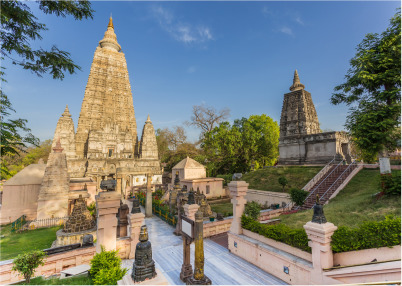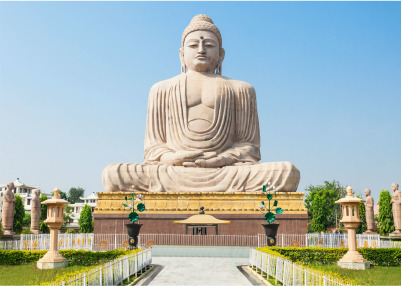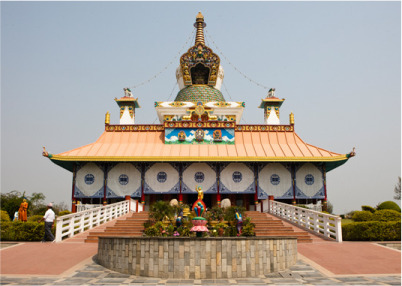Golden Triangle with Buddhist Circuit
- 11 Nights/ 12 Days
- india
- Delhi – Jaipur – Agra – Train – Varanasi – Bodhgaya – Patna – Kushinagar – Lumbini – Delhi
About the Tour
Starting and even ending in Delhi, this twelve days guided tour will take you to all the places that have a strong connection with the Buddha principles and teaching. Nalanda, Rajgir, Bodh Gaya, Kushinagar, Lumbini, and Shravasti are places that you will be covering on this tour. The main highlight of this trip is that apart from the Buddhist pilgrimage destinations; this tour will pass through iconic golden triangle sites - Delhi, Agra, and Jaipur.
Highlights
• Road Cruise across the major cities of India, i.e, Delhi, Agra & Jaipur
• Explore bustling Delhi, magnificent Agra and royal Jaipur
• Explore Birthplace of Buddha's, Boat ride at River Ganges
• Prominent heritage tour to like Qutub Minar, Taj Mahal, Amer Fort, etc
• Experience the architectural, cultural and ancient heritage of India
• Shopping at bustling markets of Delhi for hardcore shopaholics
Day 1: Arrive Delhi
Upon your arrival at Delhi International airport, you will meet our office airport representative. After a warm welcome at the airport, you will be driven to your pre-booked hotel and our representative will assist you in check-in formalities. Get some rest or explore the city by walk. Enjoy an overnight stay at the hotel.
Day 2: Day sightseeing in Delhi | Drive Delhi – Jaipur (265kms/ 5hrs approx)
After breakfast at the hotel, you will drive to start your excursion with Qutub Minar, it’s named after Qutub-ud-din Aibak, the first Sultan of the Mamluk Dynasty, This is the victory tower of Mughal, which indicated the beginning of Muslim rule in India. Visit Humayun's tomb is the tomb of the Mughal Emperor Humayun in Delhi, India. The tomb was commissioned by Humayun's first wife and chief consort, Empress Bega Begum, in 1569-70, and designed by Mirak Mirza Ghiyas and his son, Sayyid Muhammad, Persian architects chosen by her.
Then drive to visit India Gate, it was built to commemorate the death of India soldiers, who were killed in the North West Province during the First World War and the Afghan Conquest of 1919. Later visit President House, The official residence of the President of India. Drive pass Parliament Street and move to Connaught Place for Lunch. From here you will head to Jama Masjid, it was built by the Mughal Emperor Shah Jahan between 1650 and 1656, Jama Masjid is one of the biggest Mosques in India. Later embark your drive to Jaipur city.
“Rajasthan's beautiful Pink City Jaipur was the stronghold of a clan of rulers whose three hill forts and series of palaces in the city are important attractions. Known as the Pink City because of the color of the stone used exclusively in the walled city,” Upon arrival check-in hotel and overnight stay.
Day 3: Full day sightseeing in Jaipur
Breakfast at the hotel, enjoy an elephant ride (upto the hills) to the Amber Fort. Raja Man Singh the Rajput commander of Akbar’s army constructed the fortress-palace at the end of the 16th century. Amber is a superb example of Rajput architecture, situated on a hilltop, overlooking a lake. Casting its surreal reflection in the Maota Lake, the Amer Fort is an architectural wonder. The fort is also counted as the most excellent example of Indo-Islamic architecture.
Then move ahead to the City Palace, with amazing cultural value and architectural excellence. It is adorned with a number of gardens, edifices, and courtyards within the complex of the palace which makes it worth visiting. The next stopover will be at the Jantar Mantar, also known as the Royal Observatory, Jantar Mantar has a collection of astronomical instruments that are meticulously designed to measure the harmony of the heavens.
Later on, visit Hawa Mahal It was constructed in 1799 by Maharaja Sawai Pratap Singh to enable ladies of the royal household to watch the life and processions of the city. The top offers stunning views over Jantar Mantar and the City Palace in one direction and over Sireh Deori Bazaar in the other. In the evening, explore Bapu Bazar, a famous market in Jaipur and other local markets to enjoy shopping. Later, drive back to the hotel for an overnight stay.
Day 4: Drive Jaipur – Abhaneri – Fatehpur Sikri – Agra (245kms / 5hrs Approx)
Breakfast at the hotel, embark on your drive to Jaipur. On the way, halt at Abhaneri; this ancient village in Rajasthan is renowned for its post-Gupta or early medieval monuments, Chand Baori and Harshat Mata temple. Though the village is in ruins now, tourists throng the village to see Chand Baori which is a huge stepwell, a unique idea conceived by the natives to work as a water reservoir. Another attraction is the Harshat Mata temple, an architectural jewel on the tourism map of Rajasthan. While Harshat Mata temple symbolizes the 10th-century architecture, Chand Baori, which is fortified on all sides, is one of the largest step wells in India.
En-route, also visit Fatehpur Sikri, built by Emperor Akbar in 1569 and abandoned after 15 yrs due to scarcity of water. Predominately, a red sandstone construction sprawling over a huge area, the architectural style is very much in tune with the emperor’s dream & partakes of both Hindu & Muslim styles. See the graceful buildings including Jama Masjid, Jodha Bai Palace, Birbal Bhawan, Panch Mahal, and the Buland Darwaza. Each site endures the great creativity and historical significance of the Mughal Dynasty.
Continue to drive to Jaipur, on arrival check-in at the hotel. Overnight stay at Agra.
Day 5: Drive Agra – Varanasi (LICHCHAVI EXP, 20:30 / 06:10+1)
Early morning, visit the Taj Mahal during sunrise a symbol of love. It was built by Shah Jahan in 1631 AD and was completed in 1651. This symbol of love was built in memory of his wife Mumtaz Mahal. Described as the most extravagant monument ever build for love. Then, drive back to the hotel for breakfast and freshen-up.
Afternoon visit Agra Fort, it was built by the famed Mughal Emperor Akbar in 1565 AD, the fort is predominantly of red sandstone. Construction of the massive red sandstone Agra Fort on the bank of the Yamuna River was begun by Emperor Akbar in 1565, though additions were made up until the rule of his grandson, Shah Jahan region it has partially become Palace. After lunch, you will drive back to Delhi to board a flight for onward destination. Evening embarks on your drive to Tundla railway station to board an overnight train to Varanasi.
Day 6: Arrive Varanasi and enjoy day sightseeing in Varanasi
At 06:15 hrs, arrive Varanasi railway station and transfer to hotel check-in.
Breakfast at hotel, excursion to Sarnath: one of the three holiest sites for Buddhists. This is where the Buddha delivered his first sermon in 528 BC. There are many temples here, representing the many cultures where Buddhism is the dominant religious philosophy. You'll find the Tibetans, the Chinese, the Japanese, the Burmese and the Thai have set up centers of learning, monasteries, and temples. The Ashokan Pillar here used to be crowned by a capital that had four lions with their backs to each other looking out in the four cardinal directions the capital, now a national emblem for the Indian Union is in the Archaeological Museum in Sarnath.
Later city tour, visit world-famous Benaras Hindu University: founded by Pandit Madan Malviya at the turn of the century, also has a new Vishwanath temple. The temple, built by the Birlas, a rich industrialist family, is meant for a caste-less, egalitarian society, Tulsi Manas Temple: It’s white marble walls have the verses of Tulsidas’ Ramcharitmanas inscribed on them and Bharat Mata Temple: a modern shrine, inaugurated by Mahatma Gandhi. It has a huge relief map of the Indian sub-continent showing all its rivers, mountains and pilgrimages. Overnight at the hotel.
Day 7: Drive Varanasi – Bodhgaya (242kms / 5hrs approx)
An early morning boat ride and Ghat visit along the Ganges and catch the scene of devotees bathing and praying in the sacred water. Later drive back to the hotel for Breakfast. Check-out from the hotel and embark on your drive to Bodhgaya.
Upon arrival check-in hotel and after lunch visit Mahabodhi Temple: standing tall at 54 mts. A UNESCO World Heritage Site, this temple has been renovated over the years. It enshrines a large golden Buddha and is encompassed by an ancient railing, dating back to 100 BC. Bodhi Tree: where Buddha is said to have attained enlightenment, and the Vajrasana or throne, where Buddha sat. The tree acts as a shade to seven holy shrines situated here, said to be the places where Buddha spent a week each meditating, after his enlightenment. Animesh Lochana Chaitya Temple is where Buddha, in his second week, sat looking at the Bodhi tree, without batting an eyelid. Ratnachankrama is where Buddha spent his third week walking between the Bodhi tree and Animesh Lochana Chaitya and is also referred to as the Jewel Walk. Ratanaghara Chaitya marks the fourth week of meditation and the Muchhalinda Pond, his sixth week of meditation.
Tibetan Monastery, housing the Maitreya Buddha (future Buddha). Also, drive pass from numerous temples like Burmese Temple, Chinese Temple and Monastery, Buddhist Monastery of Bhutan, Thai Temple, and Monastery, and many more. Overnight at the hotel.
Day 8: Drive Bodhgaya – Rajgiri – Nalanda – Patna (165 kms / 4 Hrs approx)
Check out from your hotel and have a drive towards Rajgir, a place where the Buddha delivered lessons after getting enlightenment. The area is full of many places which belong to Buddha visit Vishwa Shanti Stupa: The Vishwa Shanti Stupa is on a 400 m high hill and is built in marble. The four shining statues of Buddha are on the four sides of the stupa. Venu Vana Monastery: King Bimbisar built Venu Vana Monastery as residential quarters for Lord Buddha. It was the very first present to Lord Buddha by the king. Griddhakoota Hill: At Griddhakoota Hill, Lord Buddha set in a motion his second wheel of law or Dharma Pravartan Chakra.
And, next is Nalanda. This is the town which is having a great appearance in the pages for Buddhism. This tiny village was the favorite place of Lord Buddha and Mahavira who had lived here for several years. There is a fabulous legend behind the name Nalanda, which narrates how this village got its name. It goes like this that the place where the monastery was going to be constructed was the abode of a serpent and while digging the foundation the serpent got injured. The clairvoyants of that time observed that the monastery that would have been constructed in that place would be renowned for a long. Later this Monastery turned to be a great institution of knowledge, whose unparalleled credentials gave it a unique seat in the entire history of the nation. Continue your drive towards Patna and halt the night in the hotel.
Day 9: Drive Bodhgaya – Vaishali – Kushinagar
Morning, we drive you to Kushinagar. On the way en-route Vaishali. It is a very special place for the Buddhist as it is here that Buddha delivered his last sermon and announced his implanting 'nirvana'. So, spend some time, meditating in the silence of this place. We then continue to drive to Kushinagar. Upon arrival at Kushinagar, check-in at the hotel. In the evening, we take you for the sightseeing tour of Mahaparinirvana temple and Rambhar stupa. Take pictures of these structures using your cameras so that you can carry the memories of this place along with you even on leaving Kushinagar. Overnight is at the hotel.
Day 10: Drive Kushinagar – Lumbini (170kms / 4hrs approx)
In the morning, we drive you to Lumbini. Upon arrival, just check-in at the hotel. Here we will be visiting the monuments in Lumbini and spend some time there to performing sacred ceremonies. The pilgrimage tour to Lumbini is breathtaking and so is an en-lightening destination for a devotee of Buddha. From here, visit the sacred garden of the Mayadevi temple that depicts the birth of Lord Buddha and also demonstrates the Ashok Pillar and Sakyan tank. Mayadevi, the mother of Buddha took bath in the Sakyan tank before giving birth to Lord Buddha. If interested our tour operators can arrange for a sacred bath here in Sakya tank that will surely show the divine path. Your overnight stay will be in Lumbini.
Day 11: Drive Lumbini – Gorakhpur (110kms/ 3hrs approx) | Flight Gorakhpur – Delhi (AI 9810, 15:45 / 17:45)
The morning is free for independent activity. So, take this opportunity to either play games, interact with the locals of the place, or further explore the Buddhist destinations. We then check out of the hotel and then drive you to the Gorakpur airport for a connective flight to Delhi.
Upon arrival to Delhi, our cab brings you to the hotel in Delhi. Just check-in at the hotel. Enjoy yourself in the comfort of the hotel. A cultural evening is arranged in the hotel and so you get a chance to rejuvenate and relax after a tour of 08 days. Overnight stay is at the hotel.
Day 12: Departure transfer
Early departure transfer to Delhi international airport to board flight for your home country.
Inclusions
- Accommodation on Single / Twin / Double sharing basis in offered hotels or similar
- Daily breakfast at the hotel
- All transfers and excursion will be covered by air-conditioned vehicle
- Complimentary Mineral water bottle during your tour is provided in the car
- Enjoy Rickshaw Ride in Heart of Old Delhi Chandni Chowk
- Monuments Entrance Fee as per the program.
- Elephant ride at Amber Fort in Jaipur
- 2 Tier Seat, an overnight train from Agra to Varanasi
- Services of Local English Speaking Guide for sightseeing
- Currently applicable taxes
Exclusions
- Camera charges at any monument to be paid by the guest directly
- Any airfare international/ domestic
- Any insurance
- Lunch or Dinner unless supplement for the same has opted.
- Expenses of personal nature like liquor, laundry, tips, telephone, fax, internet, etc.
- And anything not mentioned in Inclusions
Tour Notes
• Rates are subject to availability
• Room category in all packages are the base category rooms
• Rates are not applicable from 20th Dec'2019 to 10th Jan'2020.
• Christmas & New Year gala dinner charges are on a direct pay basis at the hotel by guest.
• In case we are not able to provide the same hotels as mentioned, then we shall provide similar alternate properties, change in the cost if any will be advised




